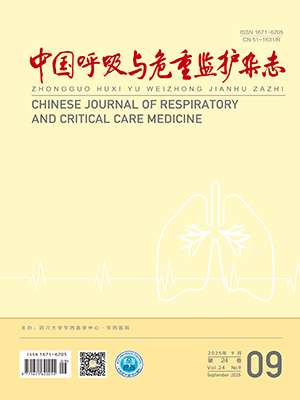| 1. |
《中华结核和呼吸杂志》编辑委员会.支气管结核的几点专家共识.中华结核和呼吸杂志,2009,32:568-571.
|
| 2. |
Xue Q,Wang N,Wang J.Endobronchial tuberculosis:an overview. Eur J Clin Microbiol Infect Dis,2011,30:1039-1044.
|
| 3. |
Kim HJ,Kim SD,Shin DW,et al. Relationship between bronchial anthracofibrosis and endobronchial tuberculosis. Korean J Intern Med,2013,28:330-338.
|
| 4. |
李彩萍,靖秋生,王卫华.1271例支气管结核临床特征和纤支镜检查结果的分析.中国内镜杂志,2013,19:354-358.
|
| 5. |
周传毅.支气管结核110例临床分析.中国内镜杂志,2006,12:1328-1330.
|
| 6. |
Kim HC,Kim HS,Lee SJ. Endobronchial tuberculosis presentingas right middle lobe syndrome:clinical characteristics and bronchoscopic findings in 22 cases.Yonsei Med J,2008,49:615-619.
|
| 7. |
李园园,胡成平,聂华萍,等. 359例肺不张支气管镜下特点分析与治疗方法探讨.第三军医大学学报,2010,32:1549-1552.
|
| 8. |
Hoheisel G,Chan BK,Chan CH,et al. Endobronchial tuberculosis:diagnostic features and therapeutic outcome.Respir Med,1994,88:593-597.
|
| 9. |
Park IW,Choi BW,Hue SH.Prospective study of corticosteroid as an adjunct in the treatment of endobronchial tuberculosis in adults.Respirology,1997,2:275-281.
|
| 10. |
Kim YH,Kim HT,Lee KS,et al. Serial fiberoptic bronchoscopic observation of endobronchial tuberculosis before and early after antituberculosis chemotherapy. Chest,1993,103:673-677.
|
| 11. |
Lee JH,Park SS,Lee DH,et al. Endobronchial tuberculosis:clinical and bronchoscopic feature in 121 cases.Chest,1992,102:990-994.
|
| 12. |
Chung HS,Lee JH. Bronchoscopic assessment of the evolution of endobronchial tuberculosis. Chest,2000,117:385-392.
|
| 13. |
Chung HS,Lee JH,Han SK,et al. Classification of endobronchial tuberculosis by the bronchoscopic features. Tuberc Respir Dis,1991,38:108-115.
|
| 14. |
Shin JA,Chang YS,Kim TH, et al. Fiberoptic bronchoscopy for the rapid diagnosis of smear-negative pulmonary tuberculosis. BMC Infec Dis,2012,12:141.
|




